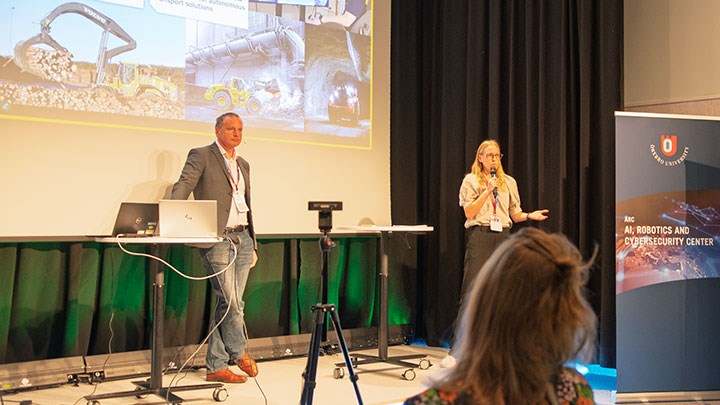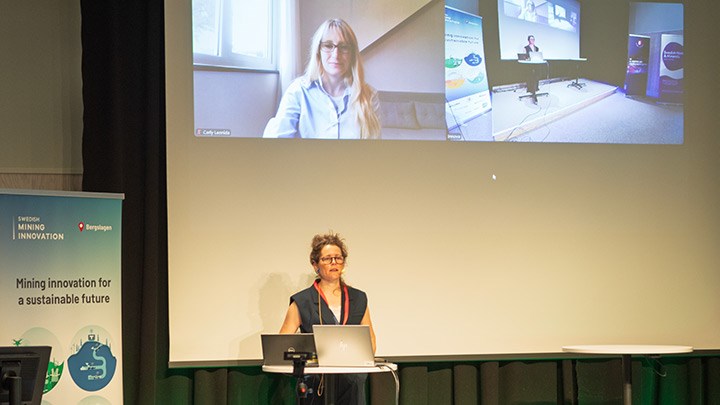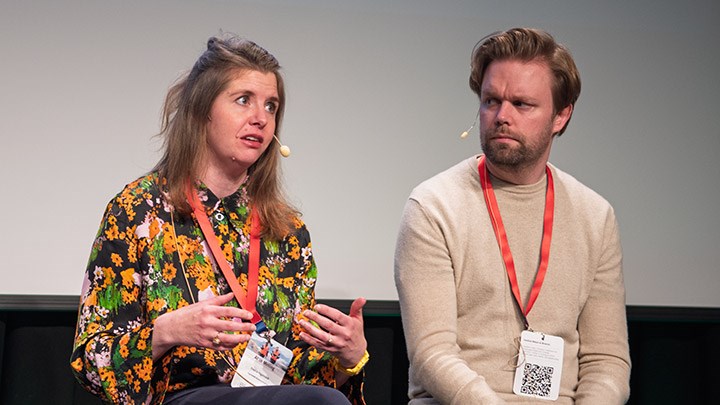AI in the mining sector: “What we’re seeing now is just the tip of the iceberg”

Peter Wallin and Alexandra Teterin discussed how Boliden and Volvo Construction Equipment are collaborating to accelerate technological development.
There is huge potential for using AI in the mining sector, both in terms of safety, profitability and sustainability. “We’re only seeing the tip of the iceberg,” said Carly Leonida, who spoke at the AI in Mining conference at Örebro University.
AI in Mining brings together business leaders and technology experts from the mining and metals industry, researchers and innovators in AI, digitisation, and automation, as well as representatives from international and national industry collaborations and startups and SMEs focused on mining technology.
Almost a hundred people participated digitally or in person when ARC – Centre for AI, Robotics and Cybersecurity at Örebro University organised AI in Mining, which this year had the theme “AI and automation in the mining sector”.
Increased safety – and sustainability
Carly Leonida is a UK-based technology journalist who has covered the mining industry for fifteen years. Her perspective was international, with examples from mining industries from around the world where new technologies are contributing to increased safety, lower energy consumption, higher production and lower costs.
“AI is nothing new to companies in the mining sector. It's almost impossible to imagine large-scale mining without technology somewhere in the value chain. But what we're seeing now is just the tip of the iceberg when it comes to the potential of artificial intelligence in mining,” said Carly Leonida.

Boliden and Volvo – ten years of collaboration
Peter Wallin from Boliden and Alexandra Teterin from Volvo Construction Equipment shared how Boliden and Volvo have collaborated for ten years to jointly embrace new technologies.
“We identified the shift in technology and the potential it offers the industry in terms of safety, productivity, efficiency, and availability,” said Alexandra Teterin.
Their collaboration began with small-scale projects and has increasingly involved additional partners over the years, including other companies, universities, and research centers. They both emphasized that collaboration has been a key success factor.
“It’s one thing to test in the lab but quite another to make it work in the mines. Involving the right people at an early stage and having an open and transparent dialogue are crucial, as well as agreeing on a common vision,” says Wallin.
“It’s also great fun to work together. I’d say it helps accelerate our progress,” says Alexandra Teterin.
New research from Örebro University
Visitors also heard presentations on research and innovation projects in AI, digitalisation, and automation. Several AI researchers from Örebro University shared their findings.

The day concluded with a panel discussion led by Lotta Sartz, project manager for Swedish Mining Innovation Bergslagen. She noted that the human-centric perspective resonated in many of the day’s presentations. She emphasised the significance of organisational culture, professional development, and change management for the successful technology deployment in practice.
“I think Emelie Fågelstedt stressed this point particularly well: that the AI revolution is not just about technology, but about people. And about creating environments where employees feel safe to learn new things and be part of the transformation. Which is also why these kinds of meeting places are so important – to bring together actors from research, industry and different sectors to spark new ideas, inspire unexpected collaborations and help us rethink how we design the innovation projects of the future,” said Lotta Sartz, summing up the day.
Text: Anna Lorentzon
Photo: Jerry Gray
Translation: Jerry Gray
